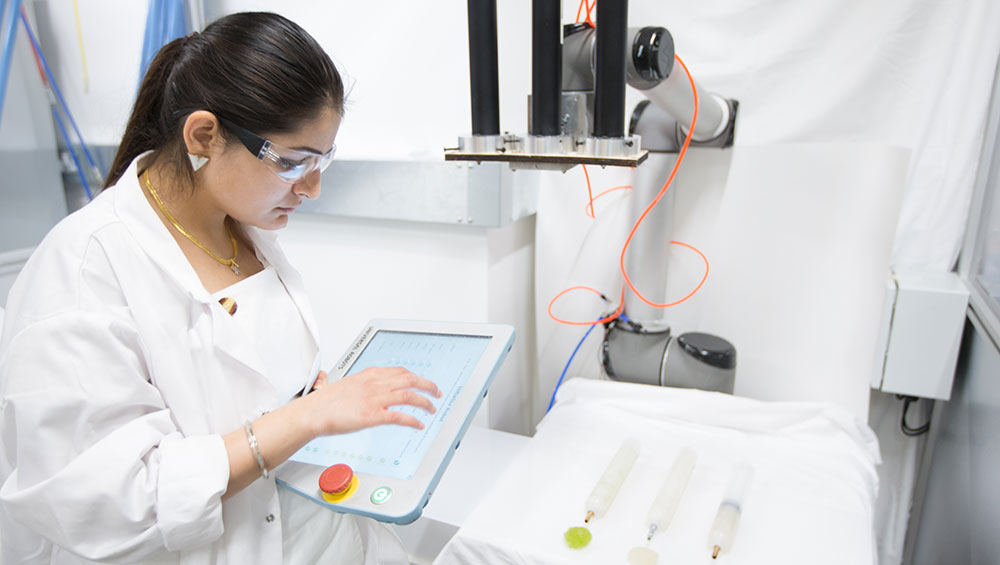
Shneel Malik doing computational work in the lab. Photo courtesy Shneel Malik.
by VERONICA SIMPSON
“Water pollution is one of the largest contributors to climate change and the largest environmental cause of death in the world,” so begins the Youtube clip introducing the architect turned bio-designer Shneel Malik’s Indus project, which has been awarded the 2021 Arts Foundation Prize for Materials Innovation. This elegant design proposes applying handmade, locally produced ceramic tiles to the exterior wall of a building, their carefully contoured grooves filled with bio-algae that clean waste water as it passes over their surface from a top-mounted dispenser, to be recirculated into the factory from the trough at its base.
Malik and her collaborators in the Bio-Integrated Design Lab at the Bartlett, University College London’s world leading architecture school, focused this project on industrial waste, and particularly the textile industries in India, in part because of Malik’s connections with the country (she was born in Delhi), and also because so much of the world’s textiles come from small-scale artisan production in developing countries. This innovative, low-cost solution has more chance of winning converts at a grassroots level and having a cumulative impact than some infrastructural mega-project. Industrial waste is a huge problem: figures given in the Indus video – attributed to the UN World Water Development Report 2020, Water and Climate Change – are as follows: “More than 2 million tons of industrial wastewater is generated each day, of which, worldwide, 80% to 90% is discharged into the environment without any form of treatment.”
Indus has been several years in the making, a product of intensive research and experimentation conducted by Malik and her collaborators at the Bio-Integrated Design Lab, specifically Professor Marcos Cruz and Dr Brenda Parker. One of the reasons why this product was awarded the prestigious Arts Foundation prize (worth £10,000) was its blend of science, craft and architecture, the accessibility of its manufacture and also its beauty. The tiles’ surfaces are inspired by the grooves and veins of leaves, as one of nature’s most efficient, water-dispensing systems. For each project, a particular tile design will be created using computational algorithms to ensure optimal water flow patterns, specific to the pollutants and the conditions on that site, so every Indus wall will be unique. Though the tile mould may be 3D-printed, part of the appeal of the project is the ease with which the tiles can be manufactured on site, using local clays or other materials, minimising transportation costs, reducing the product’s carbon footprint and providing additional work for local artisans. Post-firing, a seaweed-based hydrogel containing micro-algae will be injected into the grooves, capable of filtering out even the harshest toxins, including heavy metals such as cadmium. The installation will also entail a commitment to maintenance, however. Though the micro-algae should remain active for several months, after this time, the tiles will need to be removed, cleaned, reinjected and returned to their position.
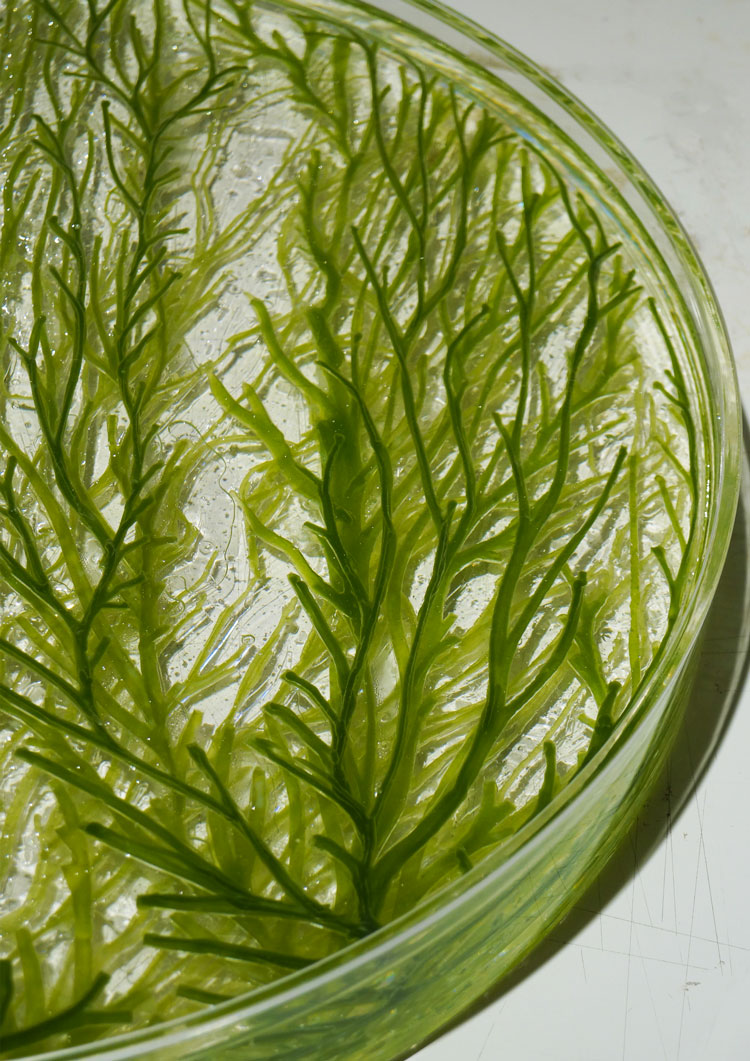
Inspirational structure for tile design. Photo courtesy Shneel Malik.
Malik’s previous research projects have enjoyed international exhibition exposure, appearing in the 2017 Tallinn Architecture Biennale, and at La Fabrique du Vivant (The Fabric of the Living), Centre Pompidou, Paris in 2019, while Indus’s first outing was at the Design Museum (Beazley Designs of the Year 2020).
Shneel received her BA in architecture from Amity University in India, going on to work for a large Indian architectural practice on infrastructure projects. She then moved to the Bartlett for her master’s in architecture, as part of the Biotechnology and Architecture Lab (BiotA), and is currently completing her pHD.
Studio interviewed Shneel Malik on Zoom from her London base, in February.
Veronica Simpson: What was your journey into bio-design, having started out in architecture?
Shneel Malik: I did my BA in architecture in India. Then I worked on airport infrastructure projects, masterplans for cities – which were aiming to become smart cities at that time – but I was not happy with how energy was managed within buildings. With sustainability in my heart, I applied and started my master’s at the Bartlett. When I first came to the UK in 2013, Professor Marcos Cruz (now professor of innovative environments) at the Bartlett was starting a lab investigating potential alliances between bio-technology and architecture, called BiotA. It was a one-year programme at that time, and I was in the first batch. After the first year, we were just beginning to scratch the surface of something that might become really interesting. Through that, with Marcos and Dr Brenda Parker (professor of biochemical engineering), I started my PhD within what turned into the Bio-Integrated Design Lab, which is now a two-year master’s programme at UCL. These collaborations between myself, Marcos and Brenda were vital, as I was beginning to explore new materials to perform photosynthesis. The idea was: how can our skin and membranes breathe and perform like the skin of a leaf? And if it can do that, what else can it do?
The idea at the beginning of the PhD was to interact as an architect with bio-chemical engineers and biologists and we began to grow experiments in a small kitchen space. Now, we have our own lab in the university. We started to develop and test water-based materials and look at how water content is managed through micro-algae cells that are embedded within the material, allowing this material to breathe and allowing the cell to exchange gases with the environment, multiplying over a period of time.
The idea was to develop photosynthetic skins. Biomedicine is the only other field that is investigating such materials, but those are for the purposes of drug testing or treatments such as wound dressing. The idea of creating a completely bio-compatible scaffold that becomes one with the environment of the human body was really interesting. So we picked on some of those recipes and started to play around with them. Instead of human cells, we used micro-algae cells or photosynthetic cells. That was the start of this journey.
VS: That sounds like quite a leap for someone who started out studying architecture. Were you always a bit of a science geek?
SM: I did have a science background of sorts. I never knew how to bridge it with architecture. When I saw that little door slip open, I jammed my foot in it and thought: this is my spot. I always enjoyed building networks, mind-maps in my head, and creating new relationships and concepts across disciplines. But terms such as bio-integrated design or bio-compatible are not generally used within architecture. They are used within science way more. We feel that, linguistically, when we are talking about sustainability or green building design, these terms have been abused and haven’t been defined well enough. Therefore the wider public uses them very loosely now and then. That’s why, as an academic and now as a potential social entrepreneur, it becomes very important to me to clearly define the remits and the ambition plus the limitations of what we are trying to do when it comes to bio-design. Instead of the term bio-design, we use bio-integrated design because it’s not just art, it’s more functional architecture and the idea is for it to do more than just be constructed or fabricated from bio-materials or materials that can be degraded over a period of time. That is a very important conversation within our lab. And with that we’re able to build good collaborations with engineers, we’re able to ask the difficult questions now because we’re able to define and point up what the problem is. We can go into the lab and say: “What else can this thing do apart from just look really nice?”
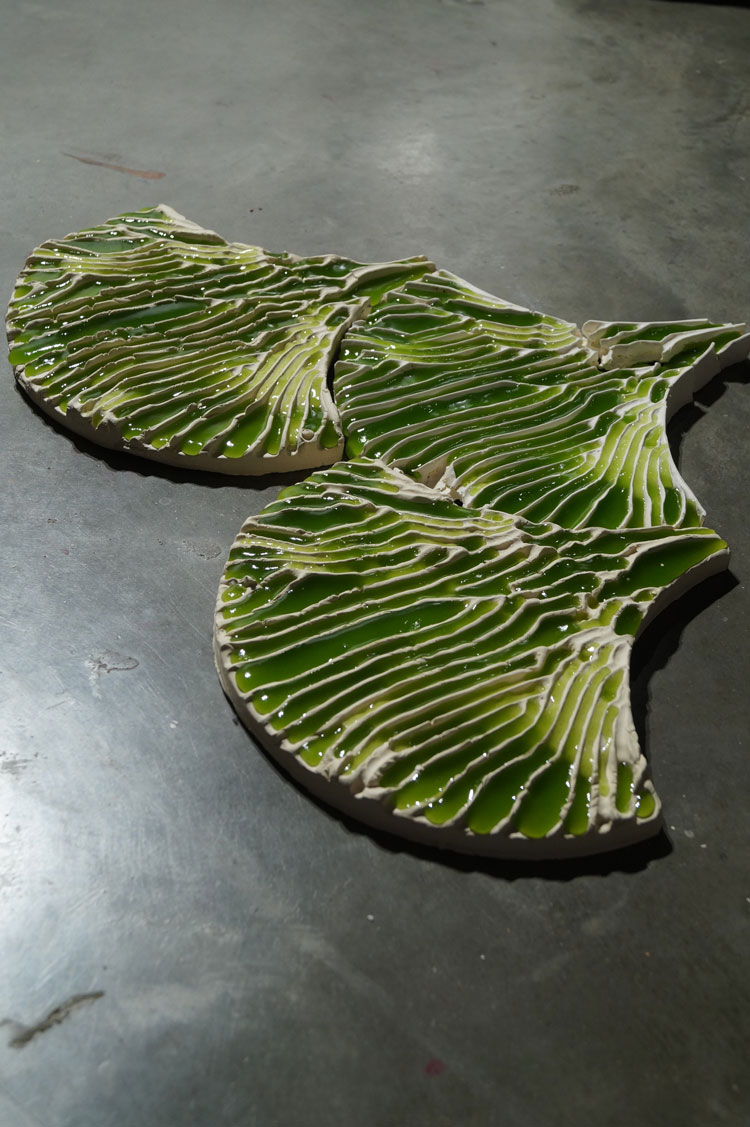
Indus wall tiles. Photo courtesy Shneel Malik.
VS: You have said that a key part of bio-integrated design is to stimulate behavioural change. How does that relate at the minute to what you do, which is still at a speculative and experimental stage?
SM: The biggest point that really annoys us is when we are asked to contribute to exhibitions, where the work is on display for months, and no one wants to maintain those living elements. Anything that’s living as a prototype needs to be maintained - these cells need to be hydrated. We’ve submitted some of our work at the Centre Pompidou and to the Design Museum in London. These things need to be taken care of, they need to be gardened; they need their nutrients every now and then.
Also, when we make this material available in the public domain, how does the normal public interact with it? How does it become part of a weekly activity in which recycling or treating waste water becomes part of their activity? That’s why the project in the end was designed for this (artisan, small-scale factory) scenario. We started going into the field, to work with small-scale artisans and understand the amount of water that people were using and what was in it, and that’s how we started to conceive of an ecological niche where this thing could become part of the urban environment.
VS: So the visual appeal and the scale and ease of manufacture of the tiles is part of what you hope will get people to engage with and look after them? There are some lovely examples on the video that went with the Arts Foundation award. Are any of these working examples, or are they all experiments?
SM: Those were demonstrations that we did. Then we went back into the lab. We identified a few more limitations or things we needed to tailor, and we’re doing the third iteration and taking it again into the field. Obviously, this is something that is important: to go back and forth, make little experiments, explore improvements in design, and then put it out again.
VS: What you say about behavioural change – wanting people to learn how to maintain and nurture their bio-engineered assets - is not dissimilar to the way in which architects need to achieve buy-in from communities for which they design new buildings, especially those that use new energy-saving technologies. I have lost count of the times architects are frustrated by maintenance staff not understanding or wanting to commit to the sophisticated technologies their buildings offer. What is the reaction of these small-scale artisans? Are they interested in what you are offering?
SM: I think they do feel empowered now. In some places, because there is so much happening with climate change, governments are clamping down, introducing policies to say: “If you pollute this much you will be shut down.” And governments don’t provide solutions. They just make a law and enforce it. Small-scale artisans who are in abundance are often working for massive companies, such as H&M, but these company supply chains are not as circular as they should be. So they definitely do enjoy the potential of being able to treat and reuse the water because the world is getting dryer. Whatever water they get is already contaminated. They are helpless to a large extent. They recognise now that the kinds of diseases that run in their families are because of heavily polluted water. But also when we go into the community, it’s important for us to tell them a different story … a story of how they really can use design in setting new standards not just for themselves but for future generations. We are also talking about potential employment opportunities. In order for locals to maintain these new sustainable technologies, we will be training local females in the community to give them a task. We will have local resident district officials based within a community, who will be able to understand where photosynthetic skin or biomaterial needs to be replaced. But, also, in an ideal scenario, we will encourage people to grow local micro-algae species instead of having fancy lab-grown algae.
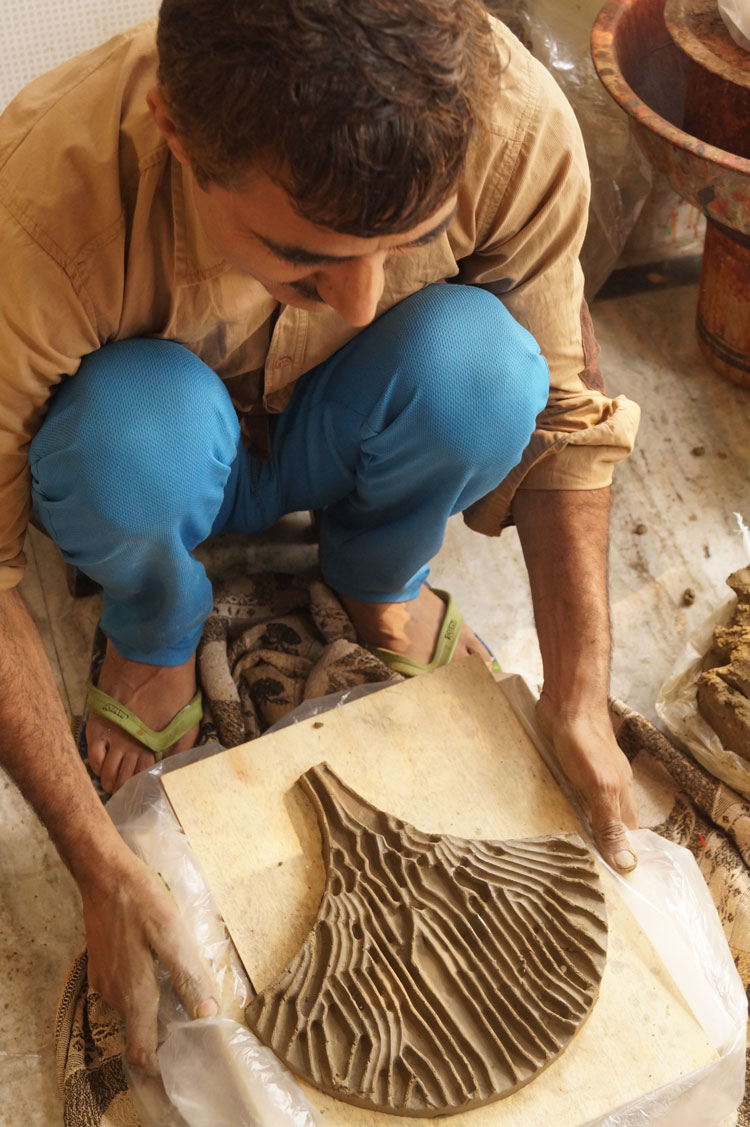
Indus clay wall tile manufacturing, using traditional methods, India. Photo courtesy Shneel Malik.
It is based on the circular economy principle. But there are still problems to resolve: what happens to the heavy metals now that are in the material, in the wall? Who disposes of them? There are industries that know how to upcycle this. So If local artisans know how to carefully collect it, if they give it to an industry that is able to upcycle it, then there is an incentive-based model between these two communities. That is the sort of a model that we are trying to get into the community. It has to happen one step at a time. There are a lot of things that overlap on paper, but you need to have different conversations on different levels because people play different roles within the supply chain. In the next year, I want to build two distinct models and show how developed and developing countries can use the same high tech and low tech simultaneously. It can be sustained in both environments.
However, I do understand that these tiles are ceramic, and to make ceramic tiles you have to fire them, which releases a lot of energy. Now we are doing experiments to use alternative materials.
VS: Do you have any people ready to sign up to this?
SM: We did make a website and there is a link for joining the community. People have written to us from India and also the UK, from Imperial College, who want to understand how this system works. We need to go out and collect more data, because for things such as water and water-pollution, the data isn’t readily available.
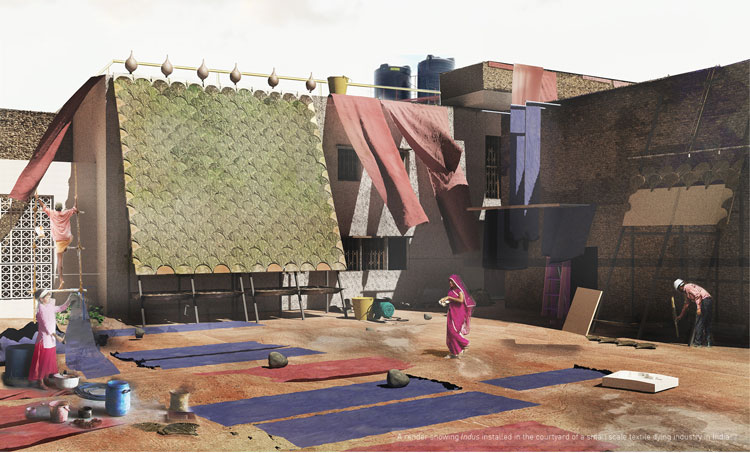
Shneel Malik. Render of Indus installed in the courtyard of a small-scale dying industry in India. Photo courtesy Shneel Malik.
VS: What support do you have in terms of funding and making this happen? What is your dream scenario?
SM: We’d like to be able to collaborate with certain textile companies, for instance, whose supply chain needs these small artisans. At the minute, we don’t know how much pollutant is there, but also we don’t have centralised treatment plants, so there is an opportunity to get out there and try to (work on this small scale) and see how much of the percentage of water we would be able to recycle.
We are talking to NGOs to engage with these communities because they understand them much better than we do. We also want to talk to policy-makers in terms of regulation. If they pass a law against pollution, they need to give examples of how you can treat this water. Then government could incentivise the installation of the systems. It’s a coalition, this system of social entrepreneurship; we want to create a foundation with certain private partners.
When I go for these (social entrepreneur) elevator pitches, I probably ask for £200,000 to go for the next year and show the potential for construction of these things on the larger scale. We have talked with some investors. But they hesitate when they realise there is a little bit of research and development still to do.
VS: That does seem to be the barrier for a lot of the innovative technology I have seen within bio-design, bio-architecture. There is a lot of fascinating research, but little evidence of it entering the mainstream. There are also very few media outlets or publications through which people can find out about this fascinating field.
SM: You might see images in magazines such as Dezeen and when people see them, they get excited and want to know where they can get hold of them. But, mostly, they are not yet available, or they are incredibly expensive.
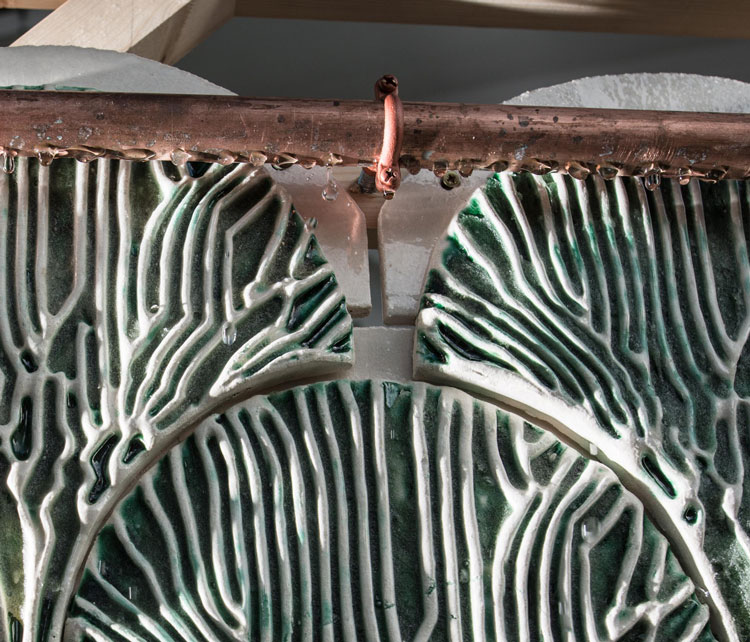
Inlet detail. Photo courtesy Shneel Malik.
VS: You mentioned costs earlier. Obviously, Indus is a beautiful product, but is it an expensive one?
SM: No, biomaterial is super cheap, it’s made from food-grade ingredients. Tiles can be fabricated from any locally available material. The little investment would be the one-time installation frame on which you plug the tile and you keep reusing that every time you replace the tiles.
VS: In an interview on BBC Radio 4, you said that, with each different location and technology, you would need to tailor the tile and its structure and design to suit the particular conditions and pollution levels. Would that be expensive to implement?
SM: Well, as an architect, you never design the same building again. So, we would approach this by developing a computational system in which you would explore the local conditions and respond with what’s needed. There are specific parameters that can be used to calculate the response. By creating something different every time, it gives an identity to each community, and that’s an added attraction.
For me, this is very important in bio-design. You never see the same plant growing in the same way in two places. I’m probably exaggerating this importance. It might or might not work in the same way. But I want to make each project different and distinct. It needs to be tailored to the local environment. The thinking needs to shift ever so slightly. It should not be mass-produced, but should be mass-distributed.
VS: You talked just now about becoming a social entrepreneur. Are you hoping to set up a business to propagate this technology?
SM: Yes. UCL is helping me do that. UCL Innovation and Enterprise and Bio-Integrated Design Lab and the Bartlett are helping me do this. It’s a creative design-model challenge. It lets me do the design and research and development, but also lets me make it happen. For someone who comes with the vision and belief, it’s important for me to demonstrate how circular economy models and bio-economic models can be executed.
VS: It strikes me that, within Europe, the most ambitious programmes for integrating environmental policies with social and economic structures that support sustainability are in Belgium, Holland or Scandinavia. There needs to be more awareness and intelligence of how what we do in one area impacts on another.
SM: With COP 26 (the UN Climate Change conference) coming to Glasgow this year, it’s the UK’s opportunity to really push. In terms of research, the UK is probably one of the top countries producing incredible amounts of super-innovative research. When it comes to platforms to showcase this research in the public domain, it’s still behind others. For me, it’s not just about writing articles and books, it’s about making useful and informative sites available. Not just exhibitions. In the last five years, there have been incredible bio-design exhibitions in London, but you see bio-designers coming out of the Royal College of Art, Central Saint Martins and UCL and struggling to find opportunities to work in this field.
Sometimes, there might be an opportunity to find a job in the US, for some eco-clothing initiative. But there’s maybe only one position a year. Imagine the possibilities in food, agriculture and civil engineering, if they just accepted one graduate in these fields and gave them a year to come up with some ideas. They could get some really interesting projects rolling.
VS: In that case, this award is particularly useful for boosting the profile of what you are doing and bio-design in general?
SM: Absolutely. I think the platform is incredible. The Arts Foundation Award comes at a very good time. And because the Clothworkers’ Company funds the materials innovation award, I feel that has opened up a lot more opportunities because our project is about working with the textile industry with small-scale artisans. We’ve got more support in going out and having conversations with these age-old associations and communities and with people who understand the local community and the local industrial perspective. Obviously, the funds are fantastic, because they can fund more research. Most of us are doing this work because we love it, not because we’re being paid a lot. We all have other jobs to keep us going. But the platform, the recognition and the conversations are now rolling in by themselves. People are listening to us a bit more and that is also important. I’m a crazy optimist. I know that the right opportunity comes at the right time. The Indus project is managing to do way beyond what I had expected.